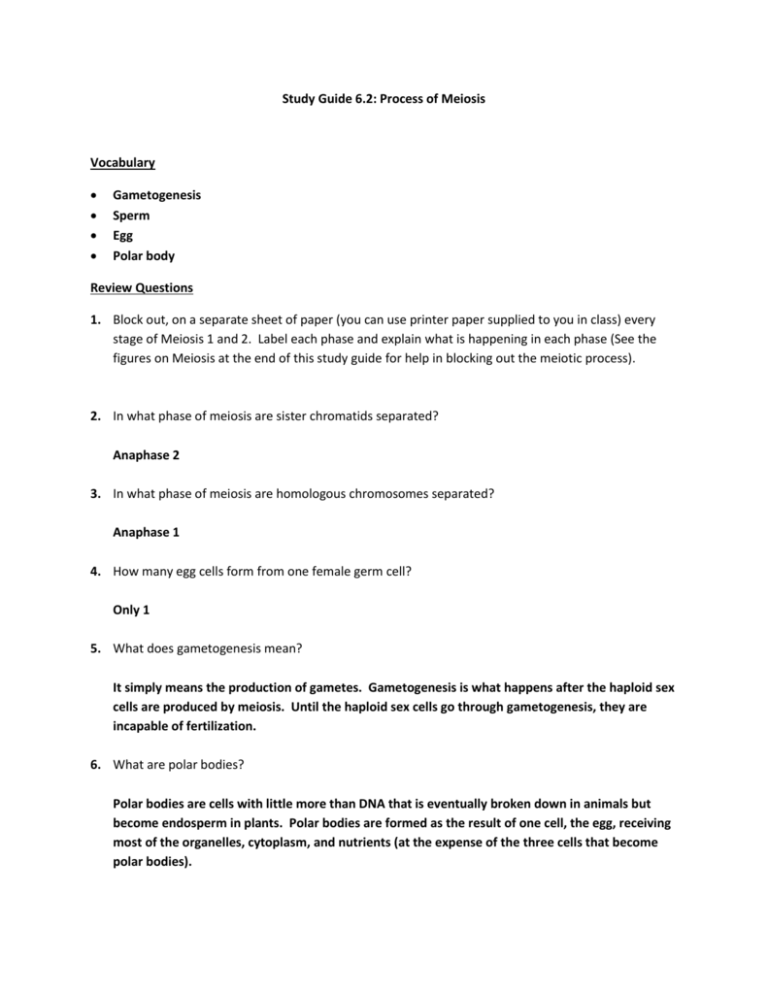Meiosis Study Guide: Vocabulary, Phases, and Review Questions
advertisement

Study Guide 6.2: Process of Meiosis Vocabulary Gametogenesis Sperm Egg Polar body Review Questions 1. Block out, on a separate sheet of paper (you can use printer paper supplied to you in class) every stage of Meiosis 1 and 2. Label each phase and explain what is happening in each phase (See the figures on Meiosis at the end of this study guide for help in blocking out the meiotic process). 2. In what phase of meiosis are sister chromatids separated? Anaphase 2 3. In what phase of meiosis are homologous chromosomes separated? Anaphase 1 4. How many egg cells form from one female germ cell? Only 1 5. What does gametogenesis mean? It simply means the production of gametes. Gametogenesis is what happens after the haploid sex cells are produced by meiosis. Until the haploid sex cells go through gametogenesis, they are incapable of fertilization. 6. What are polar bodies? Polar bodies are cells with little more than DNA that is eventually broken down in animals but become endosperm in plants. Polar bodies are formed as the result of one cell, the egg, receiving most of the organelles, cytoplasm, and nutrients (at the expense of the three cells that become polar bodies). 7. What is the major difference between metaphase 1 and metaphase 2? In metaphase 1, pairs of homologous chromosomes line up at the equator. In metaphase 2, the chromosomes are not paired. 8. How do homologous chromosomes differ from sister chromatids? Homologous chromosomes are two separate chromosomes – one from your mother and one from your father. Homologous chromosomes are very similar to each other – having the same length and carrying the same genes. They are not genetically identical and are not copies of one another. Sister chromatids are genetically identical, duplicated chromosomes. Sister chromatids are attached at their centromere and are divided during meiosis 2. 9. Explain why an egg is so much larger than a sperm cell? An egg needs to provide cytoplasm, organelles, nutrients and other building blocks for life to begin; a sperm needs only to reach the egg and deliver its DNA, so it is streamlined and small. 10. List the key differences between meiosis 1 and 2? Meiosis 1 begins with a diploid germ cell and produces two haploid cells, has homologous chromosomes separate, and is where crossing over and recombination takes place. Meiosis 2 divides sister chromatids and results in undoubled chromosomes and 4 haploid sex cells. DNA is not copied during the interphase between meiosis 1 and 2. 11. Compare and contrast the differences between meiosis and mitosis? Describe how the steps of meiosis 1 differ from those of mitosis. Meiosis has two cell divisions while mitosis has only one cell division. During meiosis, homologous chromosomes pair up along the cell equator. During mitosis, homologous chromosomes never pair up. In anaphase 1 of meiosis, sister chromatids remain together. In anaphase of mitosis, sister chromatids separate. Meiosis results in haploid cells. Mitosis results in diploid cells. 12. (Challenge Question – 2 Points) Briefly explain how a sperm cell’s structure is related to its function? The sperm cell’s primary contribution to an embryo is DNA. By losing cytoplasm and gaining a tail and numerous mitochondria, the sperm cell can swim through the uterus and donate DNA to the egg.







